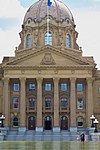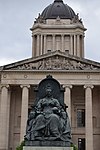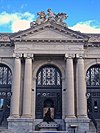Pedimental sculptures are sculptures within the frame of a pediment on the exterior of a building, some examples of which can be found in Canada. Pedimental sculpture poses special challenges to sculptors: the triangular composition limits the choices for figures or ornament at the ends, and the sculpture must be designed to be viewed both from below and from a distance.

History
As with the ancient Greeks, and the Roman architects and sculptors who followed them, North American artists had two different structural approaches creating pedimental sculpture. They are either freestanding statues that stand on the bed (the ledge or cornice that creates the bottom of the pediment), or they can be relief sculpture, attached to the back wall of the pediment.[citation needed][1]
Compositionally, the restrictions imposed by both the physical triangular shape of a pediment, and the traditional themes that are usually employed for the subject matter, are, according to Ernest Arthur Gardner, "as exactly regulated as that of a sonnet or a Spenserian stanza: the artist has liberty only in certain directions and must not violate the laws of rhythm".[2]
The Golden Dog

Perhaps the most famous pedimental sculpture in Quebec is Le Chien d'Or (c.1688) in Quebec City.[3] The gray limestone relief panel depicts a dog gnawing a bone,[4] a metaphor for nursing a grudge.
Timothée Roussel (c.1639-1700), a French immigrant and surgeon, was a Quebec City landowner in New France,[4] and Jean Normand was his neighbor.[3] The two bickered over right of passage across Normand's land, and Roussel won in court over Normand in 1682 and 1683.[3] The men eventually came to blows, and wound up in court again in 1686.[3] The court record noted that Normand's son Joseph had killed Roussel's dog.[3]
Two years later, Roussel built a house on Buade Street, and affixed the bas relief panel over his front door.[4] It featured a menacing inscription:
"I am a dog that gnaws his bone / I couch and gnaw it all alone / A time will come, which is not yet / When I'll bite him by whom I'm bit." (Translation by William Kirby, 1877.)[5]: 116
Merchant Nicolas Jacquin, dit Philibert[6] bought the house from Roussel's heirs in 1734, and greatly expanded it.[7] The merchant was murdered in 1748.[8] Philibert's house was later converted into a coffeehouse,[7] was the meeting place for Freemasons from 1775 to 1800,[7] and served as the city's post office from 1845 to 1871.[7] The house was demolished for construction of a large Second Empire post office building, completed in 1872.[9] Roussel's panel was mounted high above its side entrance.[7]
Author William Kirby made the relief panel the centerpiece of his 1877 historical novel The Golden Dog.[5] The lead character was Philibert's son, who tracks down his father's killer and avenges the murder. The novel helped to make Le Chien d'Or famous, but also popularized the urban legend that the relief panel was erected as a threat to Philibert's murderer.[3]
The post office building was expanded and remodeled in a Beaux-Arts style in 1913.[9] The then-225-year-old relief was relocated to a more prominent location, a segmental pediment over the building's new entrance porch.[10]
Manitoba Legislative Building

The 1911-1912 British-Empire-wide design competition for the Manitoba Legislative Building in Winnipeg had 67 entrants, and was won by Scottish architect Frank Worthington Simon.[11] He chose Scottish sculptor Albert Hodge to design its sculptured main pediment.[12] Hodge died in 1918 at age 42, three years prior to the building's completion. Piccirilli Brothers of New York City carved Hodge's pedimental figures in limestone.[11]
The pediment group which was modelled by the late Albert Hodge, of London, attracts attention first by its conspicuous situation as well as by its artistic quality. In judging such a group it must be borne in mind that the height above the eye, its peculiar confining frame and the necessities of its composition make it one of the most difficult of sculptural problems. Mr. Hodge, however, has most successfully developed his subject, filling the outer acute angles of the pediment as well as the high apex, the composition being balanced on either side and culminating at the centre. The female figure of Manitoba sits full front in the middle, and to the left there are three distinct groups, connected and related to the central figure by sentiment and gesture. In the corner Enterprise beckons the workers to the Land of Promise. Next there is a finely modelled bull led by Europa typifying the emigration from Europe, and between this group and Manitoba, there are a father, mother and child—the new family in the new world. On the opposite side of the angle are two figures clasping a jar whence issues a stream of water fertilizing the earth—the confluence of the Red and Assiniboine rivers. Next is a group of ploughmen and horses, tilling the soil, balancing the Bull-and-Europa group. Between these and Manitoba is a group of a man and a woman bringing the fruits of the soil, balancing the family group. Thus are expressions and balance complete, scale maintained, and the space well filled.
Mr. Hodge's work is also seen in the two sphinxes, representing Wisdom and Knowledge, placed on either side of the main pediment, and in the group of two figures, personifying, respectively, Peace and War, above the east and west pediments.[11]
Pedimental sculptures
| Building | Province | Location | Image | Sculpture | Sculptor | Architect | Installed | Medium / Notes |
|---|---|---|---|---|---|---|---|---|
| Alberta Legislature Building | Alberta | Edmonton; 10800 97 Avenue NW |  | central crest incorporating provincial shield | tbd | Allan Merrick Jeffers and Richard Blakey | 1913 |  |
| Bank of Montreal, Calgary branch | Alberta | Calgary; 8th Avenue and 1st Street SW |  | version of the bank's coat of arms | tbd | Kenneth Rea[13] | 1932 | Listed on the Canadian Register of Historic Places[14] |
| Merchants' Bank of Canada, Victoria branch | British Columbia | Victoria; 1225 Douglas Street |  | Bank of Montreal coat of arms | tbd | Francis M. Rattenbury, architect[15] Honeyman & Curtis, 1922 expansion[16] | 1907 1922 |  Bank of Montreal purchased the building in 1922, and expanded it, adding a pedimental sculpture of the BOM coat of arms. Listed on the Canadian Register of Historic Places[17] |
| Manitoba Legislative Building[18] | Manitoba | Winnipeg; 450 Broadway |  | enthroned central figure of Manitoba, figures representing the Red River and the Assiniboine River at far right | Albert Hodge, sculptor Piccirilli Brothers (New York City), carvers[19] | Frank Worthington Simon and Septimus Warwick | 1920 | Manitoba Legislative Building:  Listed on the Canadian Register of Historic Places[20] |
| Winnipeg Law Courts Building | Manitoba | Winnipeg; 391 Broadway |  | blindfolded Justice with sword and scales, flanked by two figures | tbd | Victor W. Horwood[21] | 1916 | Horwood (1878–1939) was provincial government architect Pediment sculpture commission was won by open competition[22] Listed on the Canadian Register of Historic Places[23] |
| New Brunswick Legislative Building | New Brunswick | Fredericton; 706 Queen Street |  | central shield | unknown | James C. Dumaresq | 1882 | Listed on the Canadian Register of Historic Places[24] |
| Colonial Building | Newfoundland and Labrador | St. John's; Military Road |  | lion and unicorn, in a version of the Royal coat of arms of the United Kingdom | unknown | James Purcell | 1847 |  Listed on the Canadian Register of Historic Places[25] |
| Bank of Montreal, Sydney branch | Nova Scotia | Sydney; 175 Charlotte Street |  | central shield | tbd | Sir Andrew Taylor | 1901 | Twin pediments on north and west facades, carved from olive green sandstone Listed on the Canadian Register of Historic Places[26] |
| Province House | Nova Scotia | Halifax; 1726 Hollis Street |  | lion and unicorn, in a version of the Royal coat of arms of the United Kingdom | unknown | John Merrick | 1819 | Province House:  Listed on the Canadian Register of Historic Places[27] |
| Bank of Montreal, Cambridge branch | Ontario | Cambridge (Galt); 44 Main Street (at Water) |  | central shield in low relief | tbd | Hogel & Davis | 1919 | Built by the Merchants' Bank of Canada |
| Bank of Montreal, Hamilton branch | Ontario | Hamilton; James and Main |  | Bank of Montreal coat of arms | tbd | Kenneth G. Rea | 1928 | Listed on the Canadian Register of Historic Places[28] |
| Rideau Hall (Government House) | Ontario | Ottawa; 1 Sussex Drive |  | lion and unicorn, in a version of the Royal coat of arms of the United Kingdom | tbd | David Ewart, 1914 expansion | 1838 1865-1868 1914 |  Pediments not original construction, date from 1914 construction of Mappin Hall Listed on the Canadian Register of Historic Places[29] |
| St. Lawrence Hall[30] | Ontario | Toronto; 157 King Street east |  | depiction of former coat of arms of Toronto | John Cochrane and brothers[31] | William Thomas | 1851 |  Listed on the Canadian Register of Historic Places[32] |
| Ancienne Banque de Montréal | Quebec | Gatineau; 40 promenade du Portage |  | Curved fragmental pediment with Bank of Montreal coat of arms | Edward and William Sutherland Maxwell | 1907 | Listed on the Canadian Register of Historic Places[33] | |
| Ancienne-Douane (old customs house) | Quebec | Montréal; 150, rue Saint-Paul Ouest / place Royale |  | Albion, representing Great Britain, solitary female figure with trident and shield[34] | unknown | John Ostell | 1836 |  current statue replaces wooden original;[34] Listed on the Canadian Register of Historic Places[35] |
| Bank of Montreal Head Office | Quebec | Montreal; 119, rue Saint-Jacques |  | Bank of Montreal coat of arms: two First Nations figures flank a seal with motto Concordia salus (here with two European pioneers)[36] | Sir John Steell | John Wells[37] | 1847 |  |
| Bonsecours Market | Quebec | Montreal; 350, Rue Saint-Paul |  | abstract design | tbd | William Footner | 1847 | Listed on the Canadian Register of Historic Places[38] |
| Le Chien d'Or The Golden Dog | Quebec | Quebec City; Louis S. St.-Laurents Building, 3, Rue De Buade |  | gold-painted limestone relief panel of a dog gnawing a bone | unknown | Pierre Gauvreau, builder | 1688 (sculpture) 1872 (building) 1913 (expansion) |  Listed on the Canadian Register of Historic Places[39] |
| London and Lancashire Life Building | Quebec | Montreal; 244, rue Saint-Jacques |  | several minor ornate pediments on main and flanking facades | unknown | Edward Maxwell | 1898 |  |
| Maisonneuve Municipal Library (Bibliothèque Maisonneuve) | Quebec | Montreal; 4120 Ontario Street East |  | central seal with inscription | tbd | Cajetan Dufort[40] | 1910-1912 |  (l'Hôtel de Ville de Maisonneuve) |
| Maisonneuve Public Bath and Gymnasium | Quebec | Montreal; 1875–1877, Morgan boulevard, Borough Mercier-Hochelaga-Maisonneuve |  | blind pediment, with figural acroteria | Arthur Dubord[41] | Marius Dufresne[42] | 1916 |  |
| Montreal Masonic Memorial Temple | Quebec | Montreal; 2295 Saint-Marc Street and 1805 Sherbrooke Street West |  | two caped male athletes flank a coat of arms with signs of the Four Evangelists | tbd | John Smith Archibald | 1929 | Montreal Memorial Masonic Temple:  Listed on the Canadian Register of Historic Places[43] |
| Ravenscrag, Hugh Allan Residence | Quebec | Montreal; 835-1025 Avenue des Pins Ouest |  | coat of arms (motto Spero), scrollwork and foliation carved in deep open-bed pediment | unknown | Victor Roy and John W. Hopkins | 1863 | Segmental pediment dormer:  |
| Rialto Theatre | Quebec | Montreal; 5723, avenue du Parc |  | a pair of segmental pediments with escutcheons | unknown | Joseph-Raoul Gariépy | 1924 |  Listed on the Canadian Register of Historic Places[44] |
| Saint-Joseph du Mont-Royal | Quebec | Montréal; 3800, chenin Queen Mary |  | escutcheon flanked by palm branches | Paul Bellot | 1937-1941 | Listed on the Canadian Register of Historic Places[45] | |
| Prince Edward Building | Saskatchewan | Regina; Scarth Street and 11th Avenue |  | minor segmental pediments over 3rd story, and triangular pediments over 4th story, contain abstract carving | unknown | David Ewart | 1907 | aka Old Post Office |
| Saskatchewan Legislative Building | Saskatchewan | Regina; 2405 Legislative Drive |  | Center: Enthroned figure of Canada Left: Seated Aboriginal, his wife and infant, tools and handicrafts Right: Seated settler, his wife and 2 children, cow, sheep and plow[46] | Canadian members of the Bromsgrove Guild of Applied Arts[47] | Edward and William Sutherland Maxwell | 1912 |  Listed on the Canadian Register of Historic Places[48] |
See also
References
External links
 Media related to Pediments in Canada at Wikimedia Commons
Media related to Pediments in Canada at Wikimedia Commons
